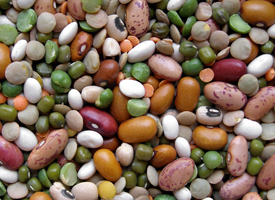Fiber is important for anyone with diabetes. You’ve probably heard time and time again about the role that carbohydrates play in blood glucose management. Carbs include sugars, starches and fiber.
What is fiber?
 Fiber is technically the indigestible part of plant foods that pushes through our digestive system, absorbing water along the way. (If you’re looking for a a technical explanation of dietary, soluble, and insoluble fibers check out this detailed explanation here.)
Fiber is technically the indigestible part of plant foods that pushes through our digestive system, absorbing water along the way. (If you’re looking for a a technical explanation of dietary, soluble, and insoluble fibers check out this detailed explanation here.)
When we eat carbs that are high in fiber, they are digested more slowly than those that have little to no fiber. The best way to get fiber is to eat foods that are naturally high in fiber, rather than in foods that have fiber added to them.
Counting carbs with fiber
As a general rule, foods that have undergone the least amount of processing are higher in fiber (and healthier!) If you are counting carbohydrates to determine your insulin dose, you can subtract 1/2 of the grams of fiber from the total amount of carbohydrates in a food
- An example:
1/2 cup canned black beans contains 22 grams carbohydrate, of which 9 grams are fiber. - 22 total carbohydrates (minus) 4.5 grams fiber = 17.5 gm carbohydrate for purposes of determining insulin dose.
Foods rich in fiber
Whole grains
A well known whole grain is wheat. Whole wheat berries are ground to make whole wheat flour; the ground whole wheat is sifted to remove the wheat germ and bran to make white flour. Whole wheat flour is a much healthier choice than white flour.
An even better high fiber carb choice are wheatberries themselves. cook them whole and use them in salads, pilafs, casseroles, soups or as a hot cereal. They take longer to be digested and absorbed than whole wheat flour. For a diabetic, that means that the carbohydrate in wheat berries will cause a slower rise in blood glucose than those found in whole wheat flour products.
Legumes, like beans, peas and lentils are some of the highest fiber foods around. They also make use of carbs in the form of starch, protein and a lot of vitamins.
Vegetables vary in carbohydrate content, but they all contain fiber. The other carbs in vegetables are a combination of starch and sugar.
The carbohydrates in fruits include mostly sugar, but also fiber–that is why it is so much better to eat whole fruit than to drink fruit juice, which is practically devoid of the fibrous material in whole fruits.
